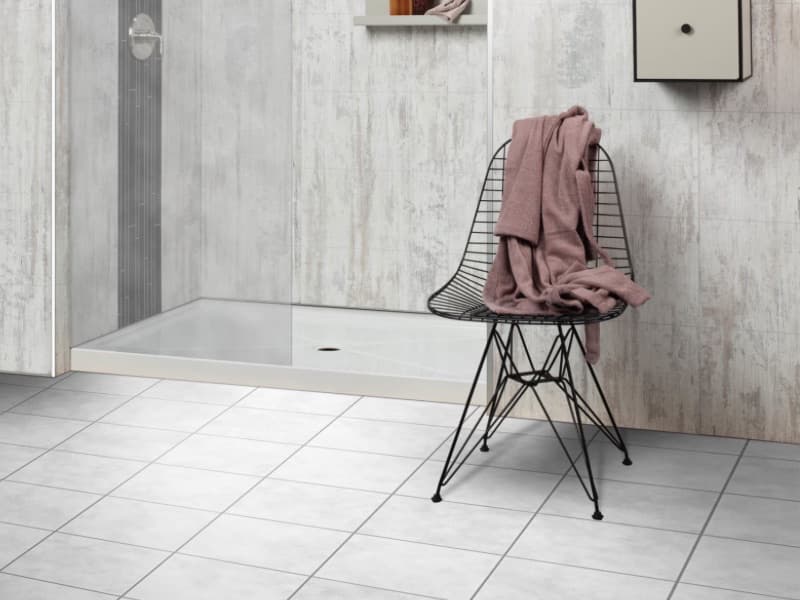Tiles give your bathroom a great look and feel, especially when properly installed. However, they take time to install and can be expensive. You may prefer to have a tile board installed in your bathroom instead. Tile board looks similar to normal tiles and takes less time to install. However, if you get a professional to handle the installation, most people can hardly tell it’s a tileboard.
Tile board looks like ceramic tiles but it doesn’t offer the same qualities as the tiles. It’s inexpensive, easy to install and maintain, and visually appealing due to its tile-like look. However, it can be easily damaged by water, lowers the house’s value, is hard to find, and appears cheap.
Properly preparing the tileboard and grooving it well will have you thinking the installation is porcelain or ceramic tiles. You need to learn everything about tile boards to achieve this goal, so read on and learn.

What is a tile board?
A tileboard is ceramic tiles’ look-alike. It’s made of thin wood fiberboard, which is then compressed and designed with furrows to give the appearance of the real tile.
The board is then covered with thin melamine to give it a tidbit of water resistance ability. Due to the melamine cover, you might assume the tile board is meant for the bathroom, which is wrong. A tileboard can work in any room in your house.
You can have the tileboard on the tub alcoves in the bathroom and the shower area. Have it on areas with minimal water overflow since it’s done once water penetrates through the thin melamine layer. The water will penetrate the fiberboard, making it swell and giving it a bad image.
The most common tileboard size is the 4 x 8-foot sheet. When planning to install one, calculate the surface area, so you know how many sheets you will need.
Types of tile board
There are several types of tileboards in the market today. The common ones include:
1. Wood Fiber Tileboard
These boards have fiber compressed beneath the melamine finish to give them the tile appeal. The wood that forms the panel is compressed to form one long sheet, mostly 4×8 feet.
These boards are ⅛ inches thick and are mostly white. They are perfect for your laundry room, kitchenette, or any high moisture area, giving your wall the tile appearance.
2. Marble Tileboard
The marble tileboard gives your wall the marble look after installation. It’s hardboard-backed, making it a favorite among tileboard enthusiasts.
In most cases, the marble tileboard comes in brown and beige colors. The sheets measure 4×8 ft and are ⅛ inches thick.
Marble tileboards are water-resistant and can work perfectly on any area in your home, especially the highly visible areas such as the bathroom, kitchen, or laundry area.
3. Aquatile Tileboard
The Aquatile is embossed and backed by a hardboard which makes it water-resistant. This tileboard gives your bathroom wall a mixture of tiles and marble appearance.
You can also choose one with mosaic inserts and patterns, enhancing the tile appearance.
It’s easy to clean and maintain the tileboard, you only need to wipe it out with a damp cloth, and you are done.
Gray color dominates this type of tileboard as it augurs well with the mosaic inserts. The aquatile sheets measure 4×8 ft, and it’s ⅛ inches thick.
Tileboard pros and cons
The main advantages of tileboards include:
| Tile Board Pros | Tile Board Cons |
| Inexpensive | Damaged by water |
| Easy to install | Lowers the value of the house |
| Easy to maintain | Hard to find |
| Visually appealing | Cheap taste for some |
1. Inexpensive
Tileboards cost a fraction of what actual tiles would cost to install. They are sold in sheets, mainly 4×8 ft, making fixing even cheaper than tiles, where you must use grout and cement on every piece.
2. Easy to Install
Tileboards take less time and effort to install. The labor it takes to cover an entire wall with the tileboards is a ¼ of what it would take if it were tiled.
If you are the handy type, you only need minimal assistance to fix an entire wall. Developing DIY skills for bathroom fixes is good, from installation to making your own tools like toilet snakes.
3. Easy to Maintain
To maintain tileboards, you only need to wipe them off with a damp cloth. For them to last, fix them in areas with less moisture. That way, the water won’t penetrate the fiberboard, which could trigger swelling and eventual damage.
4. Appealing
Tileboards have a similar appearance to tiles. At a distance, it’s hard to tell the difference.
They give you a chance to look at an affordable rate. In addition, the different types available allow you to choose the tiles you would otherwise fix at a higher cost.
The disadvantages of having tileboard on your bathroom surfaces include the following:
1. Damaged by Water
Tileboards are easily destroyed by water. When cleaning, only wipe the board with a wet cloth and avoid soaking the wall.
When exposed to too much water, the water penetrates through the board to the fiber, making it swell and not easy to repair.
2. Lowers the Value of the House
When the time comes and you want to trade your property, the tileboard will significantly lower its value.
Given the low cost of tileboards when trading off the property, the house will fetch less than if the surfaces had actual tiles.
3. Hard to Find
Tileboards are a pain to find. Given their low demand due to their poor functionality in absorbing water, tileboards are not very common, making them hard to find.
Most manufacturers abandoned their production and replaced the boards with real porcelain and ceramic tiles as their demand soared.
4. Cheap Taste for Some
Tileboards give a cheap feel to your facility. For this reason, those who install them choose to have them on the not-very-visible parts of the house.
The look on your surfaces covered with tileboards is not one you wish to have on a high-end property as it thwarts your efforts of having an expensive classic feel.
Tileboard cost
Tileboards are relatively affordable compared to actual tiles. A 4×8 foot tileboard sheet costs between $20 and $30, translating to around $1 per square foot. For instance, this is unlike porcelain tiles, which cost $5 per square foot.
You can easily install a tileboard with minimal assistance, making the labor cost even lower than the installation costs of actual tiles.
Tileboard repair and maintenance
Tileboards are easy to maintain. Only ensure you don’t expose them to too much water and moisture. You only need a damp cloth to clean them; the surface will be as good as new.
Unfortunately, if water penetrates through the tileboard, the best you can do is to replace it, as it will swell and tear off. Or, you can remove the patch that water has penetrated and replace it with a pattern that befits the rest of the board so no one notices it’s a patch.
How to install tile board in a bathroom
To install a tileboard, follow these steps:
- Sand the wall where you plan on installing the tileboard.
- Clean up the wall to remove the dust.
- Allow the wall to dry up.
- Map out the surface and cut the tileboards to size.
- Apply strong construction adhesive on the back of the tileboard.
- After 5 minutes, fit the tileboard to the wall and use a roller to ensure maximum contact between the tileboard and the wall. Apply enough force so you don’t leave spaces in between.
- After every 15 minutes, press the tileboard, especially on the edges, to remove air gaps.
- Leave to dry for 24 hours.
- Apply silicone sealant on all edges to reinforce and keep the tileboard intact.
Be careful not to damage the tile board in these steps since it’s quite delicate compared to tiles.
Tileboard vs. other bathroom paneling materials
There are different paneling materials that you can use on your wall. Below we look at how each of them compares to the tileboards.
1. Tileboard Vs. Ceramic Tiles
Tileboards and ceramics may look similar, but that is as far as it goes. The two are quite different because tileboards are cheaper to acquire and install. In addition, ceramic tiles last longer and are more moisture friendly than tileboards.
Ceramic tiles are expensive compared to tileboards. For example, ceramic wall tiles can cost up to $5 per square foot, while the tileboard costs $1 per square foot.
2. Tileboard Vs. FRP Panels
These two are similar in that they are low-cost options for paneling, and their appearance is almost similar.
The two are different in that the FRP panels are more expensive, considering a 4×8 sheet goes for between $40 and $100 while that of a tileboard the same size goes for $20.
Material-wise, the FRP panels are fiberglass or polymers embossed, while the tileboard is fiberwood reinforced.
The FRP panels have more optional styles, while the tileboards are limited. In addition, FRP panels are good at being water-resistant, while tileboards are poor at being water-resistant.
Conclusion
Tileboards work just fine if you are on a tight budget. They were the in-thing in the 1960s, but the FRP panels have since overtaken their relevance.
You can install the tileboards on your bathroom instead of the plain wall if your budget allows and improve the appearance of your property. The most outstanding feature of the tileboards is that you can easily confuse them with actual ceramic tiles at a distance.
Generally, flooring and floor covers are vital in the bathroom. There is a lot to consider, from floor tileboards to bath mats for reglazed tubs and even anti-slip floor covers.
